Abstract
1. The irritant fungal terpenoid isovelleral caused protective eye-wiping movements in the rat upon intraocular instillation and showed cross-tachyphylaxis with capsaicin, the pungent principle in hot pepper. 2. Isovelleral induced a dose-dependent calcium uptake by rat dorsal root ganglion neurones cultured in vitro with an EC50 of 95 nM, which was fully inhibited by the competitive vanilloid receptor antagonist capsazepine. 3. Isovelleral inhibited specific binding of [3H]-resiniferatoxin (RTX), an ultrapotent capsaicin analogue, to rat trigeminal ganglion or spinal cord preparations with an IC50 of 5.2 microM; in experiments in which the concentration of [3H]-RTX was varied, isovelleral changed both the apparent affinity (from 16 pM to 37 pM) and the co-operativity index (from 2.1 to 1.5), but not the Bmax. 4. The affinity of isovelleral for inducing calcium uptake or inhibiting RTX binding was in very good agreement with the threshold dose (2.2. nmol) at which it provoked pungency on the human tongue. 5. For a series of 14 terpenoids with an unsaturated 1,4-dialdehyde, a good correlation was found between pungency on the human tongue and affinity for vanilloid receptors on the rat spinal cord. 6. The results suggest that isovelleral-like compounds produce their irritant effect by interacting with vanilloid receptors on capsaicin-sensitive sensory neurones. Since these pungent diterpenes are structurally distinct from the known classes of vanilloids, these data provide new insights into structure-activity relations and may afford new opportunities for the development of drugs targeting capsaicin-sensitive pathways.
Full text
PDF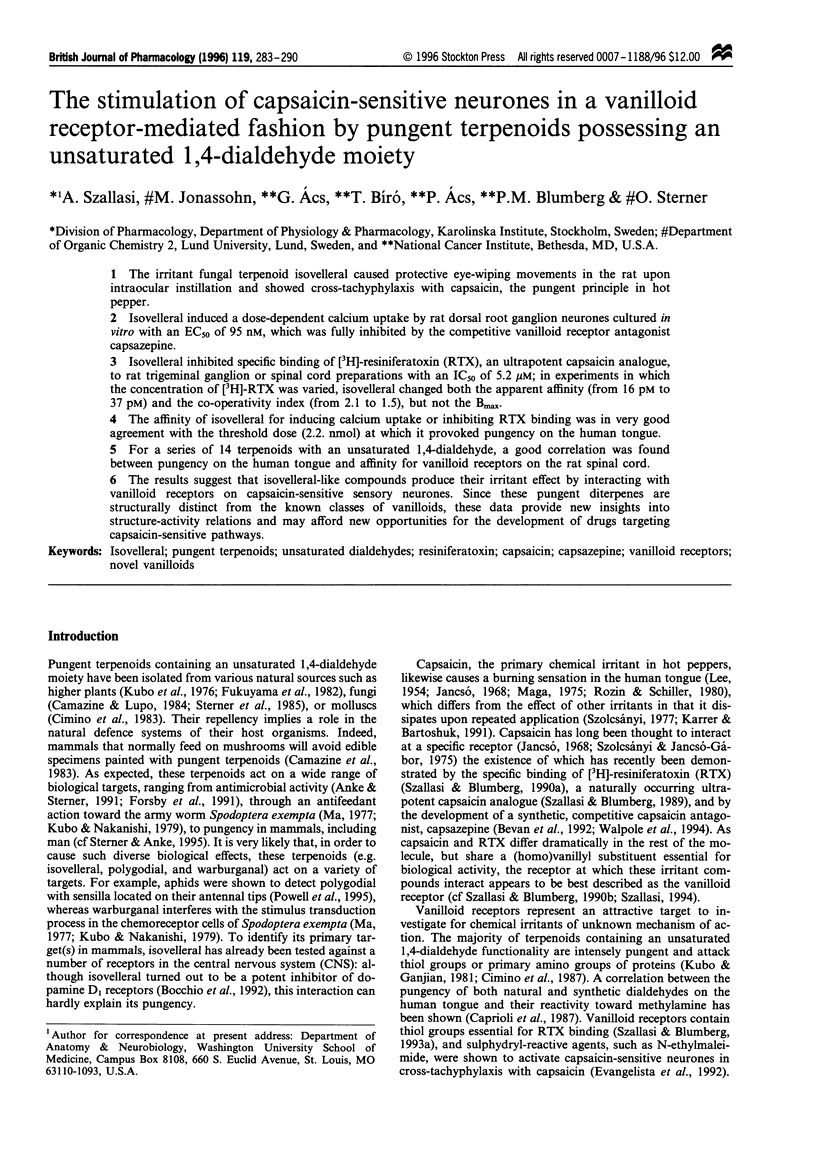
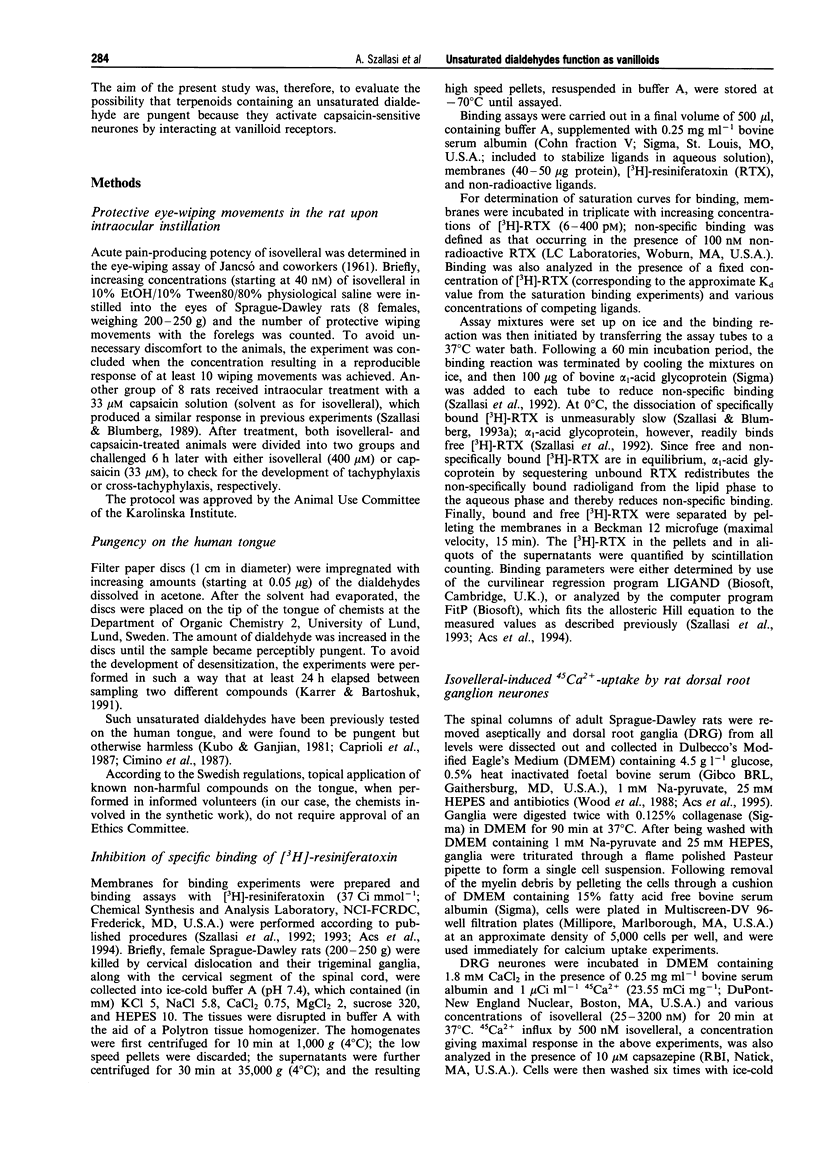
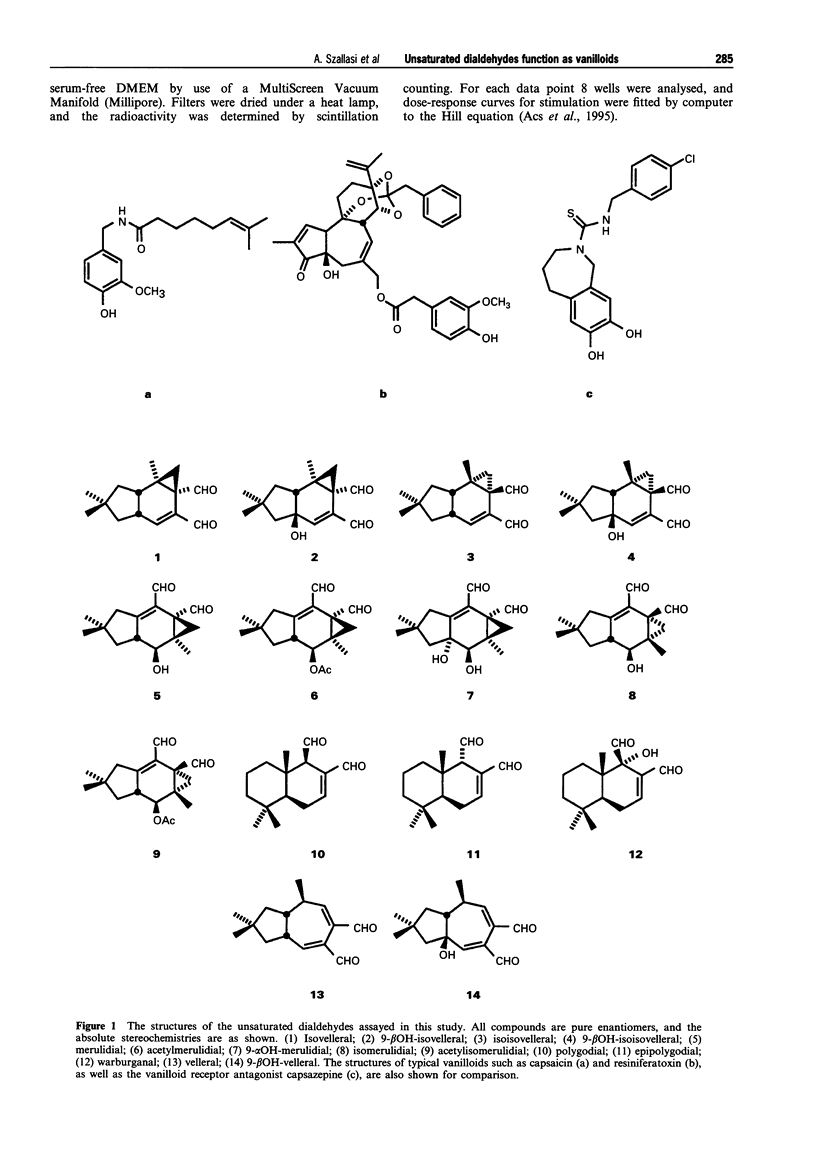
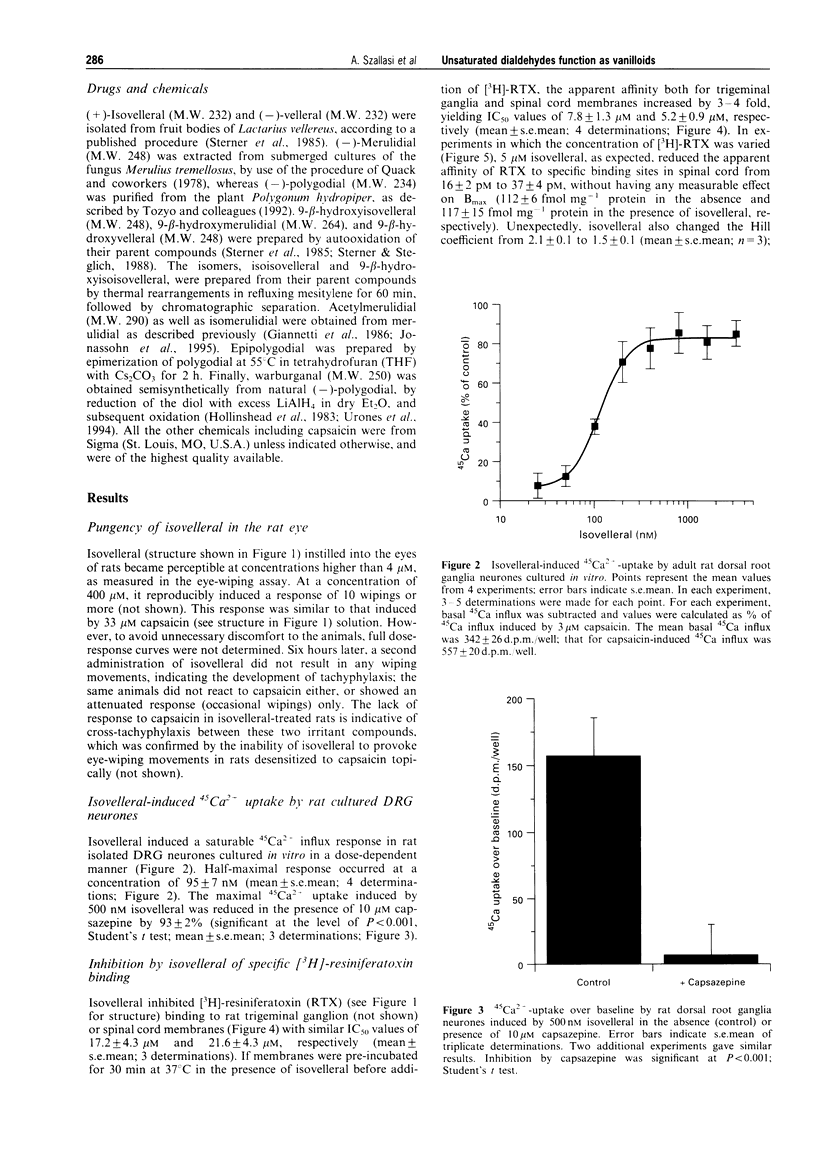
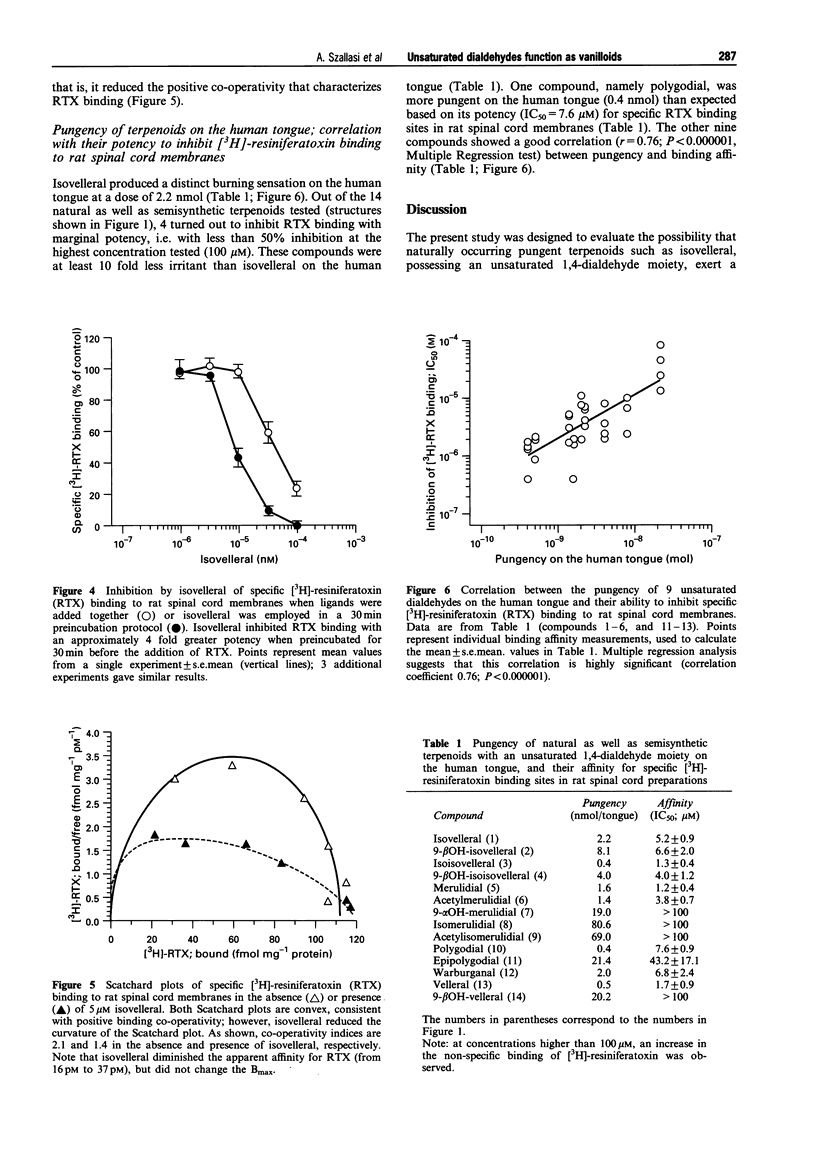
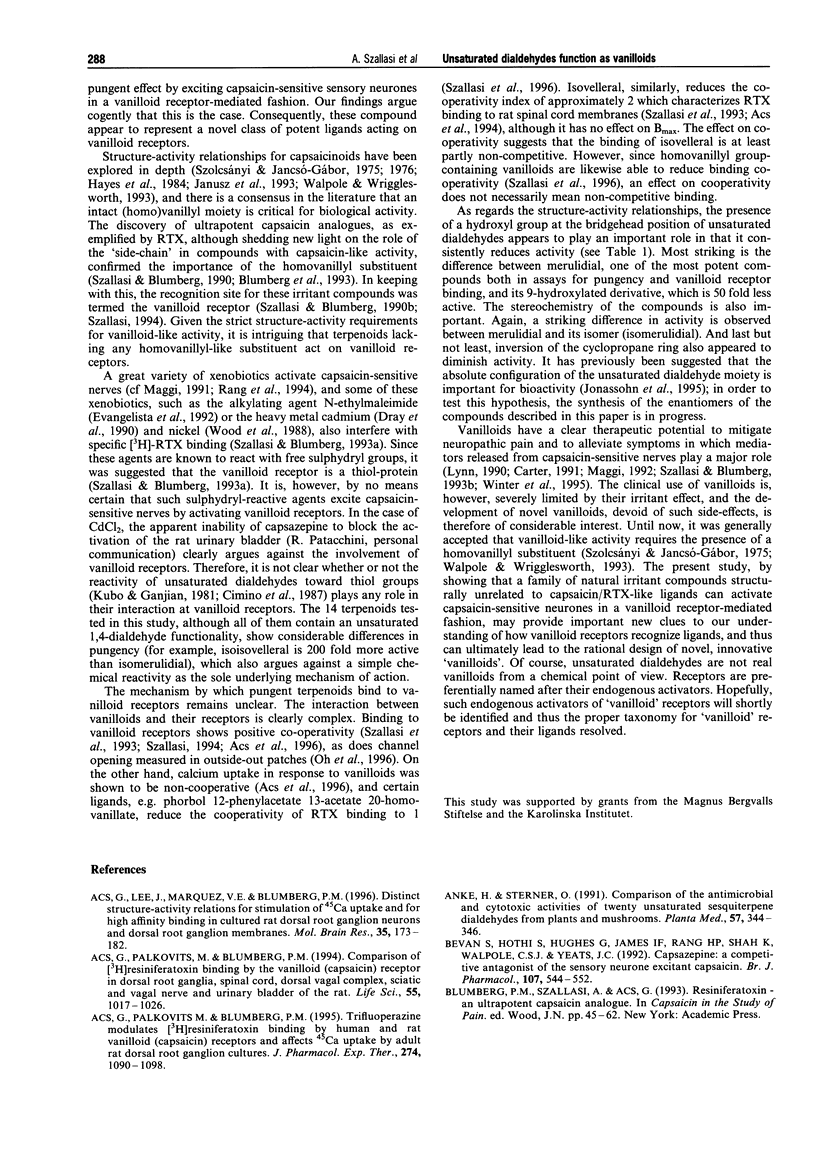
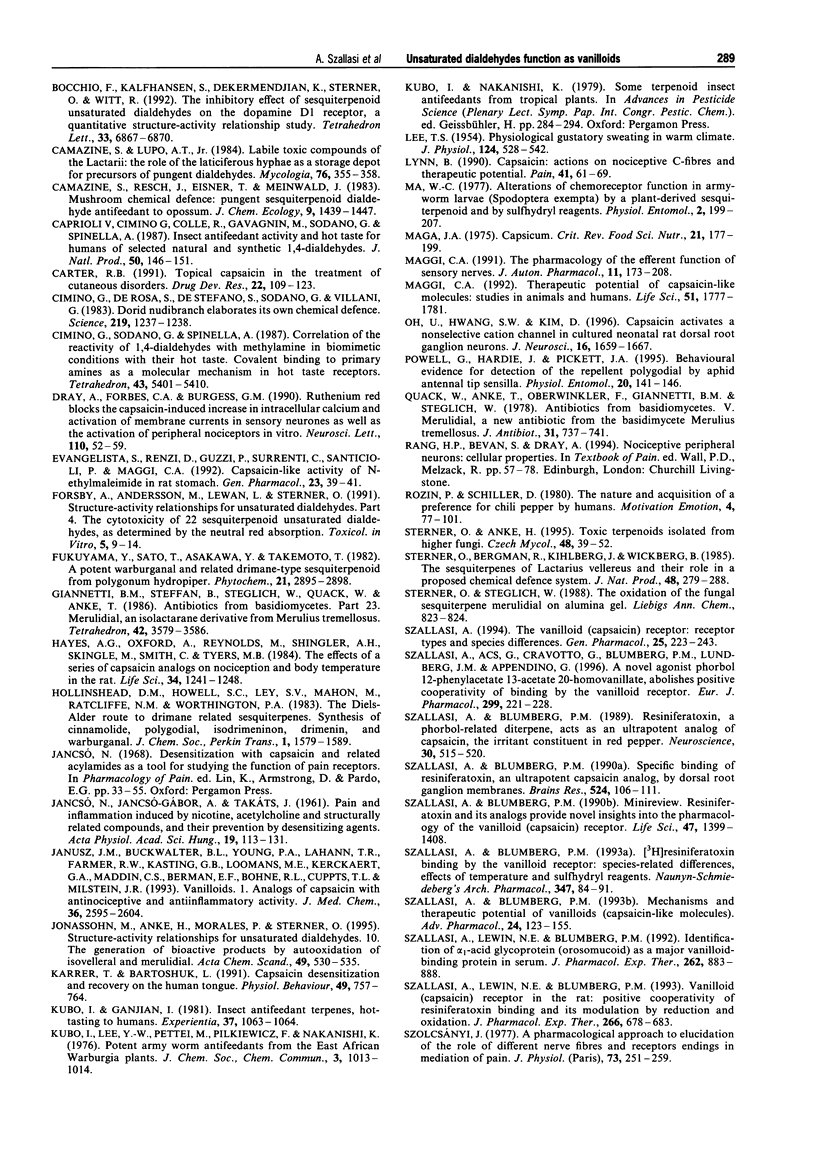
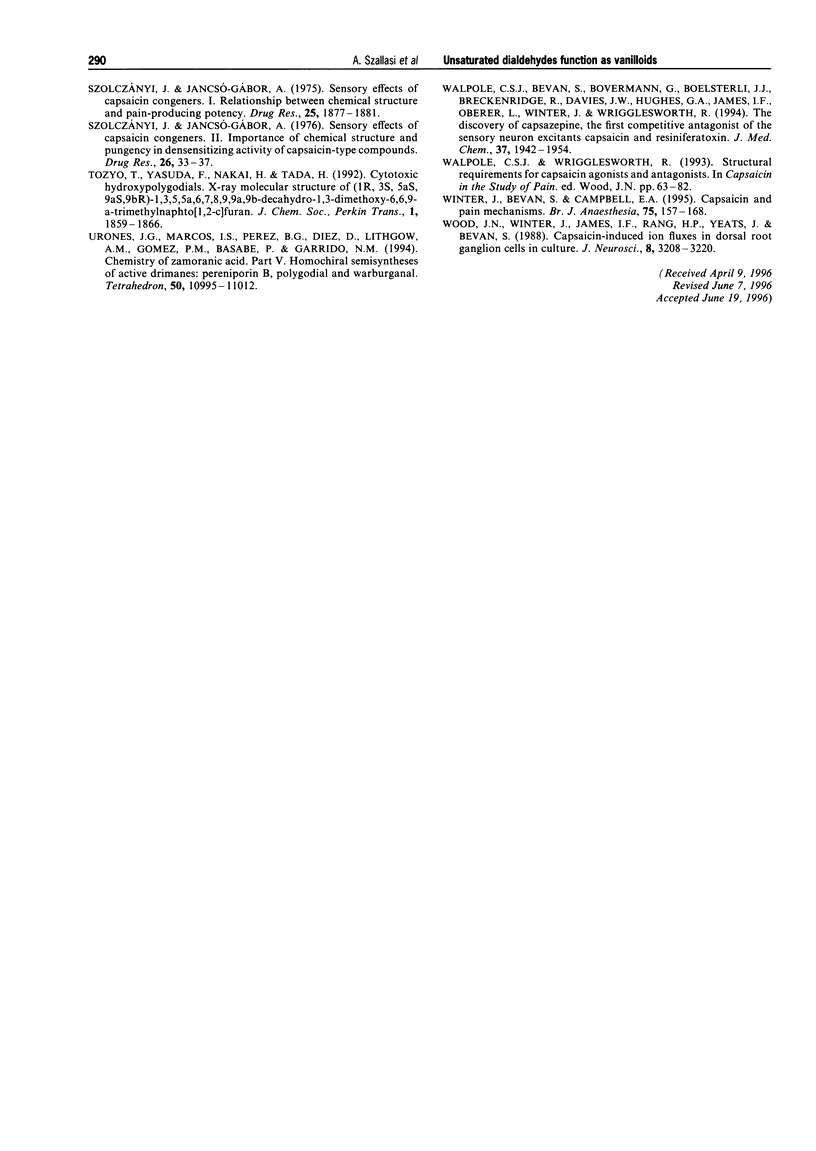
Selected References
These references are in PubMed. This may not be the complete list of references from this article.
- Acs G., Lee J., Marquez V. E., Blumberg P. M. Distinct structure-activity relations for stimulation of 45Ca uptake and for high affinity binding in cultured rat dorsal root ganglion neurons and dorsal root ganglion membranes. Brain Res Mol Brain Res. 1996 Jan;35(1-2):173–182. doi: 10.1016/0169-328x(95)00204-6. [DOI] [PubMed] [Google Scholar]
- Acs G., Palkovits M., Blumberg P. M. Comparison of [3H]resiniferatoxin binding by the vanilloid (capsaicin) receptor in dorsal root ganglia, spinal cord, dorsal vagal complex, sciatic and vagal nerve and urinary bladder of the rat. Life Sci. 1994;55(13):1017–1026. doi: 10.1016/0024-3205(94)00636-9. [DOI] [PubMed] [Google Scholar]
- Acs G., Palkovits M., Blumberg P. M. Trifluoperazine modulates [3H]resiniferatoxin binding by human and rat vanilloid (capsaicin) receptors and affects 45Ca uptake by adult rat dorsal root ganglion neurones. J Pharmacol Exp Ther. 1995 Sep;274(3):1090–1098. [PubMed] [Google Scholar]
- Anke H., Sterner O. Comparison of the antimicrobial and cytotoxic activities of twenty unsaturated sesquiterpene dialdehydes from plants and mushrooms. Planta Med. 1991 Aug;57(4):344–346. doi: 10.1055/s-2006-960114. [DOI] [PubMed] [Google Scholar]
- Bevan S., Hothi S., Hughes G., James I. F., Rang H. P., Shah K., Walpole C. S., Yeats J. C. Capsazepine: a competitive antagonist of the sensory neurone excitant capsaicin. Br J Pharmacol. 1992 Oct;107(2):544–552. doi: 10.1111/j.1476-5381.1992.tb12781.x. [DOI] [PMC free article] [PubMed] [Google Scholar]
- Caprioli V., Cimino G., Colle R., Gavagnin M., Sodano G., Spinella A. Insect antifeedant activity and hot taste for humans of selected natural and synthetic 1,4-dialdehydes. J Nat Prod. 1987 Mar-Apr;50(2):146–151. doi: 10.1021/np50050a002. [DOI] [PubMed] [Google Scholar]
- Cimino G., DE Rosa S., DE Stefano S., Sodano G., Villani G. Dorid nudibranch elaborates its own chemical defense. Science. 1983 Mar 11;219(4589):1237–1238. doi: 10.1126/science.219.4589.1237. [DOI] [PubMed] [Google Scholar]
- Dray A., Forbes C. A., Burgess G. M. Ruthenium red blocks the capsaicin-induced increase in intracellular calcium and activation of membrane currents in sensory neurones as well as the activation of peripheral nociceptors in vitro. Neurosci Lett. 1990 Mar 2;110(1-2):52–59. doi: 10.1016/0304-3940(90)90786-9. [DOI] [PubMed] [Google Scholar]
- Evangelista S., Renzi D., Guzzi P., Surrenti C., Santicioli P., Maggi C. A. Capsaicin-like activity of N-ethylmaleimide in rat stomach. Gen Pharmacol. 1992 Jan;23(1):39–41. doi: 10.1016/0306-3623(92)90044-k. [DOI] [PubMed] [Google Scholar]
- Hayes A. G., Oxford A., Reynolds M., Shingler A. H., Skingle M., Smith C., Tyers M. B. The effects of a series of capsaicin analogues on nociception and body temperature in the rat. Life Sci. 1984 Mar 26;34(13):1241–1248. doi: 10.1016/0024-3205(84)90546-0. [DOI] [PubMed] [Google Scholar]
- JANCSO N., JANCSO-GABOR A., TAKATS I. Pain and inflammation induced by nicotine, acetylcholine and structurally related compounds and their prevention by desensitizing agents. Acta Physiol Acad Sci Hung. 1961;19:113–132. [PubMed] [Google Scholar]
- Janusz J. M., Buckwalter B. L., Young P. A., LaHann T. R., Farmer R. W., Kasting G. B., Loomans M. E., Kerckaert G. A., Maddin C. S., Berman E. F. Vanilloids. 1. Analogs of capsaicin with antinociceptive and antiinflammatory activity. J Med Chem. 1993 Sep 3;36(18):2595–2604. doi: 10.1021/jm00070a002. [DOI] [PubMed] [Google Scholar]
- Jonassohn M., Anke H., Morales P., Sterner O. Structure-activity relationships for unsaturated dialdehydes. 10. The generation of bioactive products by autoxidation of isovelleral and merulidial. Acta Chem Scand. 1995 Jul;49(7):530–535. doi: 10.3891/acta.chem.scand.49-0530. [DOI] [PubMed] [Google Scholar]
- Karrer T., Bartoshuk L. Capsaicin desensitization and recovery on the human tongue. Physiol Behav. 1991 Apr;49(4):757–764. doi: 10.1016/0031-9384(91)90315-f. [DOI] [PubMed] [Google Scholar]
- Kubo I., Ganjian I. Insect antifeedant terpenes, hot-tasting to humans. Experientia. 1981 Oct 15;37(10):1063–1064. doi: 10.1007/BF02085009. [DOI] [PubMed] [Google Scholar]
- LEE T. S. Physiological gustatory sweating in a warm climate. J Physiol. 1954 Jun 28;124(3):528–542. doi: 10.1113/jphysiol.1954.sp005126. [DOI] [PMC free article] [PubMed] [Google Scholar]
- Lynn B. Capsaicin: actions on nociceptive C-fibres and therapeutic potential. Pain. 1990 Apr;41(1):61–69. doi: 10.1016/0304-3959(90)91110-5. [DOI] [PubMed] [Google Scholar]
- Maggi C. A. The pharmacology of the efferent function of sensory nerves. J Auton Pharmacol. 1991 Jun;11(3):173–208. doi: 10.1111/j.1474-8673.1991.tb00317.x. [DOI] [PubMed] [Google Scholar]
- Maggi C. A. Therapeutic potential of capsaicin-like molecules: studies in animals and humans. Life Sci. 1992;51(23):1777–1781. doi: 10.1016/0024-3205(92)90047-s. [DOI] [PubMed] [Google Scholar]
- Oh U., Hwang S. W., Kim D. Capsaicin activates a nonselective cation channel in cultured neonatal rat dorsal root ganglion neurons. J Neurosci. 1996 Mar 1;16(5):1659–1667. doi: 10.1523/JNEUROSCI.16-05-01659.1996. [DOI] [PMC free article] [PubMed] [Google Scholar]
- Quack W., Anke T., Oberwinkler F., Giannetti B. M., Steglich W. Antibiotics from Basidiomycetes. V merulidial, a new antibiotic from the Basidiomycete Merulius tremellosus Fr. J Antibiot (Tokyo) 1978 Aug;31(8):737–741. doi: 10.7164/antibiotics.31.737. [DOI] [PubMed] [Google Scholar]
- Szallasi A., Acs G., Cravotto G., Blumberg P. M., Lundberg J. M., Appendino G. A novel agonist, phorbol 12-phenylacetate 13-acetate 20-homovanillate, abolishes positive cooperativity of binding by the vanilloid receptor. Eur J Pharmacol. 1996 Mar 28;299(1-3):221–228. doi: 10.1016/0014-2999(95)00864-0. [DOI] [PubMed] [Google Scholar]
- Szallasi A., Blumberg P. M. Mechanisms and therapeutic potential of vanilloids (capsaicin-like molecules). Adv Pharmacol. 1993;24:123–155. doi: 10.1016/s1054-3589(08)60936-9. [DOI] [PubMed] [Google Scholar]
- Szallasi A., Blumberg P. M. Resiniferatoxin and its analogs provide novel insights into the pharmacology of the vanilloid (capsaicin) receptor. Life Sci. 1990;47(16):1399–1408. doi: 10.1016/0024-3205(90)90518-v. [DOI] [PubMed] [Google Scholar]
- Szallasi A., Blumberg P. M. Resiniferatoxin, a phorbol-related diterpene, acts as an ultrapotent analog of capsaicin, the irritant constituent in red pepper. Neuroscience. 1989;30(2):515–520. doi: 10.1016/0306-4522(89)90269-8. [DOI] [PubMed] [Google Scholar]
- Szallasi A., Blumberg P. M. Specific binding of resiniferatoxin, an ultrapotent capsaicin analog, by dorsal root ganglion membranes. Brain Res. 1990 Jul 30;524(1):106–111. doi: 10.1016/0006-8993(90)90498-z. [DOI] [PubMed] [Google Scholar]
- Szallasi A., Blumberg P. M. [3H]resiniferatoxin binding by the vanilloid receptor: species-related differences, effects of temperature and sulfhydryl reagents. Naunyn Schmiedebergs Arch Pharmacol. 1993 Jan;347(1):84–91. doi: 10.1007/BF00168777. [DOI] [PubMed] [Google Scholar]
- Szallasi A., Lewin N. A., Blumberg P. M. Vanilloid (capsaicin) receptor in the rat: positive cooperativity of resiniferatoxin binding and its modulation by reduction and oxidation. J Pharmacol Exp Ther. 1993 Aug;266(2):678–683. [PubMed] [Google Scholar]
- Szallasi A., Lewin N. E., Blumberg P. M. Identification of alpha-1-acid glycoprotein (orosomucoid) as a major vanilloid binding protein in serum. J Pharmacol Exp Ther. 1992 Sep;262(3):883–888. [PubMed] [Google Scholar]
- Szallasi A. The vanilloid (capsaicin) receptor: receptor types and species differences. Gen Pharmacol. 1994 Mar;25(2):223–243. doi: 10.1016/0306-3623(94)90049-3. [DOI] [PubMed] [Google Scholar]
- Szolcsányi J. A pharmacological approach to elucidation of the role of different nerve fibres and receptor endings in mediation of pain. J Physiol (Paris) 1977 Sep;73(3):251–259. [PubMed] [Google Scholar]
- Szolcsányi J., Jancsó-Gábor A. Sensory effects of capsaicin congeners I. Relationship between chemical structure and pain-producing potency of pungent agents. Arzneimittelforschung. 1975;25(12):1877–1881. [PubMed] [Google Scholar]
- Szolcsányi J., Jancsó-Gábor A. Sensory effects of capsaicin congeners. Part II: Importance of chemical structure and pungency in desensitizing activity of capsaicin-type compounds. Arzneimittelforschung. 1976;26(1):33–37. [PubMed] [Google Scholar]
- Walpole C. S., Bevan S., Bovermann G., Boelsterli J. J., Breckenridge R., Davies J. W., Hughes G. A., James I., Oberer L., Winter J. The discovery of capsazepine, the first competitive antagonist of the sensory neuron excitants capsaicin and resiniferatoxin. J Med Chem. 1994 Jun 24;37(13):1942–1954. doi: 10.1021/jm00039a006. [DOI] [PubMed] [Google Scholar]
- Winter J., Bevan S., Campbell E. A. Capsaicin and pain mechanisms. Br J Anaesth. 1995 Aug;75(2):157–168. doi: 10.1093/bja/75.2.157. [DOI] [PubMed] [Google Scholar]
- Wood J. N., Winter J., James I. F., Rang H. P., Yeats J., Bevan S. Capsaicin-induced ion fluxes in dorsal root ganglion cells in culture. J Neurosci. 1988 Sep;8(9):3208–3220. doi: 10.1523/JNEUROSCI.08-09-03208.1988. [DOI] [PMC free article] [PubMed] [Google Scholar]


